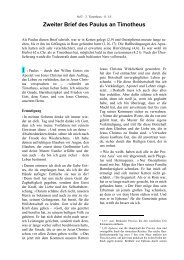Create successful ePaper yourself
Turn your PDF publications into a flip-book with our unique Google optimized e-Paper software.
Size: The sizes of human cells vary considerably.<br />
Very few of them are visible to the unaided eye<br />
or with a magnifying glass. The largest cells, the<br />
ova (egg cells), become just barely visible at a<br />
diameter of 0.15 mm (150 µm) or more. (1 µm =<br />
1 micrometre = 1 thousandth of a millimetre).<br />
Many of the larger neural (nerve) cells have a<br />
diameter of between 0.12 and 0.2 mm = 120 to<br />
200 µm. Many neural cells have extensions<br />
(processes) up to one metre or more in length,<br />
but their diameter is only a few micrometres. The<br />
sizes of most other human cells vary between<br />
5 µm and 20 µm, depending on the tissue type.<br />
Even so, some neural cells and some giant cells in<br />
bone marrow can measure up to 80 µm or more,<br />
several times the average cell size. Measuring<br />
4 to 5 µm, the glial cells (Latin glia = glue) are,<br />
along with sperm cells, among the smallest<br />
human cells. The diameter of the “heads” of<br />
sperm cells is between 3 and 5 µm. With their<br />
average diameter of 7.5 µm, the red blood corpuscles<br />
also count among the smallest cells. The<br />
median cell size is between 30 and 50 µm.<br />
Shape: Because of their special functions the<br />
shapes of most cells differ widely. They are eminently<br />
suited to their locality. Cells occurring in<br />
covering layers, like an epithelium, can be cubical,<br />
flat, or prismatic, and are as densely packed as<br />
their shapes allow. Many cells are spherical, or<br />
spindle shaped like those in the smooth muscle<br />
tissue. Nerve and connective tissue cells can have<br />
long, branching processes.<br />
Multitasking: Even though the basic plan of all<br />
cells is the same, they may differ significantly<br />
according to their function. Every kind of cell is<br />
specialised to perform certain tasks in the organism.<br />
The red blood cells (erythrocytes) transport<br />
oxygen, the nerve cells carry information, glandular<br />
cells secrete specific substances, muscle<br />
cells are responsible for body movements, and<br />
sex cells serve reproduction. The various functions<br />
of a cell are all coded for by way of specific<br />
genetic information, stored in certain sections of<br />
the DNA (desoxyribonucleic acid) of the cell itself.<br />
Pre-programmed here are processes like cell division<br />
and the synthesis of all the necessary proteins.<br />
These two processes are essential prerequisites<br />
for the development of a multi-cellular<br />
organism from a fertilised ovum. It is remarkable<br />
that such diversified cells as are found in the<br />
brain, lungs, muscles, or liver, all develop from<br />
undifferentiated precursors. Cells with different<br />
functions also have different “life expectancies”.<br />
Some cells last for only a few hours or days (eg<br />
intestinal epithelial cells), and others, like neural<br />
cells, live as long as the organism itself.<br />
Number: The estimated total number of cells<br />
constituting the human body is an astonishing<br />
100 million million (10 14 )! It is practically impossible<br />
to visualise a number like 10 14 . To count up<br />
to this number, counting non-stop at the rate of<br />
one per second, day and night, would take three<br />
million years. The number of red corpuscles in<br />
the blood, the most numerous of all the cell<br />
types, is 25 x 10 12 = 25 million million. But, unlike<br />
all other cells, they have neither a nucleus nor<br />
cellular organelles. The total number of brain<br />
cells is about hundred thousand million.<br />
Taking the average size of a cell as 40 µm, all the<br />
cells of a human body, placed side by side, would<br />
form a chain reaching 100 times around the<br />
equator.<br />
73
















